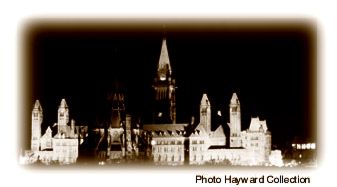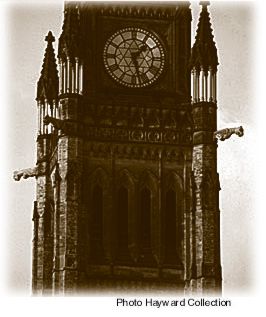Jean-Omer Marchand (1872–1936)
Omer Marchand collaborated with his younger partner, Ernest Cormier, on the 1922–23 design for l'École des Beaux-Arts in Montréal where Eleanor Milne studied in 1947–48. Both architects had studied the neo-classical Beaux-Arts manner in Paris.
 Marchand
helped design the Centre Block with John A. Pearson to replace the
Fuller and Jones building that burned in 1916. Based on the 1859 structure
and plan, they nevertheless managed to impart a more modern look to their
Gothic revival design, less pointy and frothy than the building it replaced.
Marchand
helped design the Centre Block with John A. Pearson to replace the
Fuller and Jones building that burned in 1916. Based on the 1859 structure
and plan, they nevertheless managed to impart a more modern look to their
Gothic revival design, less pointy and frothy than the building it replaced.
At age 17 Marchand had been apprenticed to Perrault and Mesnard Architects. He studied at the École du Conseil des Arts et Manufactures in Montréal and then in Paris at l'École des Beaux-Arts from which he was the first Canadian to receive an architectural diploma. When he returned to North America he opened offices in New York and Montréal with the American architect Samuel Stevens Haskell. For a brief time from 1919 to 1923 Marchand was in partnership with Ernest Cormier. They collaborated on just two buildings. They were both involved with rebuilding Montréal's city hall after a fire in 1922.
Marchand was known as an institutional architect. He designed the Bordeaux Prison and religious buildings in Montréal like Église Ste. Cunegonde in Little Burgundy, the Chapel of the Grande Seminaire and the Maison-Mère des soeurs de la congregation de Notre Dame, a building now used by CEGEP Dawson College. Little has been written about Marchand to date, but research on his career has been undertaken by a student in the Art History Master's program at Concordia University.
John Andrew Pearson (1867–1940)
John Pearson was born in Chesterfield, England and went to school in Sheffield. He immigrated to Canada in 1888 at the age of 21. By 1893 he became a partner with a past master of the neo-Gothic, Frank Darling (1850–1923), in the Toronto firm of Darling and Pearson (formerly Darling and Sproatt). They remained partners until the death of Darling.
 Darling
and Pearson are credited as an outstanding influence on Canadian institutional
architecture. They were responsible for endowing towns across Canada with
over a thousand Edwardian Baroque revival and, after 1905, Beaux Arts
style buildings, built primarily for the Bank of Commerce and the Dominion
Bank. In Toronto they designed such monumental structures as the Toronto
General Hospital, the University of Toronto and the Royal Ontario Museum.
It is said that Pearson created a Canadian icon when he designed the tower
of the new Centre Block of Parliament in 1917.
Darling
and Pearson are credited as an outstanding influence on Canadian institutional
architecture. They were responsible for endowing towns across Canada with
over a thousand Edwardian Baroque revival and, after 1905, Beaux Arts
style buildings, built primarily for the Bank of Commerce and the Dominion
Bank. In Toronto they designed such monumental structures as the Toronto
General Hospital, the University of Toronto and the Royal Ontario Museum.
It is said that Pearson created a Canadian icon when he designed the tower
of the new Centre Block of Parliament in 1917.
Pearson was principal designer and led the team that was charged by a joint parliamentary committee to add more space "without a change in the general character and style of the architecture" (Wright, 284, note 43). The Legislative Building that he and Marchand conceived was faithful to the memory of the Victorian building it replaced, but it was a roomier, more archaeologically accurate and less picturesque rendition of the Gothic. The tall Peace Tower (called the Victoria Tower until 1933) with its clock and carillon bells may be the most recognizable architectural structure in the nation, symbolizing Canada throughout the world.
References:
Canadian Encyclopedia. 1988 Ed.
Fletcher, Bannister. A History of Architecture. 18th ed. New York:
Charles Scribner's Sons, 1975.
Gournay, Isabelle & Van Laethem, France, eds. Montréal Metropolis.
Montreal: CCA, 1998.
Kalman, Harold. A History of Canadian Architecture. Toronto: Oxford
University Press, 1994.
Turner, Jane, ed. Dictionary of Art. New York: Grove's Dictionaries,
1996.
Wright, Janet. Crown Assets: The Architecture of the Department of
Public Works, 1867–1967. Toronto: University of Toronto Press, 1997.
EXTERNAL LINKS: History
and Online Tour of Parliament Buildings with many beautiful old pictures.
Restoration of
the Parliament Buildings also with many beautiful pictures.
Back to École des Beaux-Arts Album page.
Back to From Gothic France to Gothic Ottawa Album page.
LB